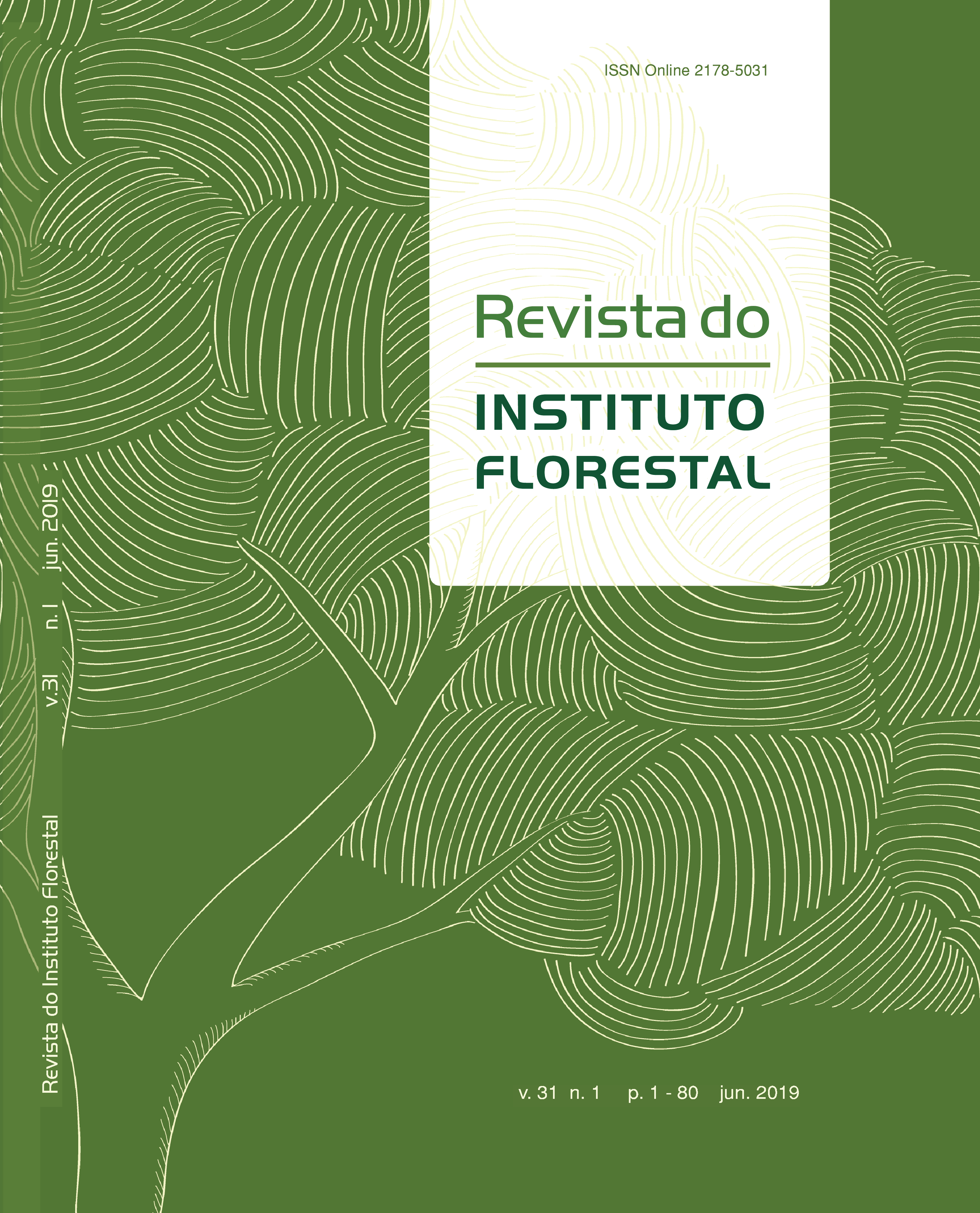EVALUATION OF EVAPOTRANSPIRATION IN Pinus elliottii AND Eucalyptus urophylla WITH FLAT DRAINAGE LYSIMETERS IN THE SERRA DO MAR, CUNHA-SP
DOI:
https://doi.org/10.24278/2178-5031.201931104Keywords:
water balance, forest hydrology, non-native forestry speciesAbstract
The evapotranspiration of Pinus elliottii var. elliottii Engelm. and Eucalyptus urophylla S.T. Black was studied in fat drainage lysimeters from planting to the age of 9 years and 11 months, during successive stages of development. The experiment was conducted at the Walter Emmerich Forest Hydrological Laboratory, located in the Cunha Nucleus of Serra do Mar State Park (São Paulo, Brazil). Evapotranspiration was calculated by the mass water balance method for short periods. Until about 3.2 years of age, the daily evapotranspiration of eucalypt was superior to that of the pine. At around 4 years of age, there was a reversal of water consumption, when the pine reached 5.5 mm/day versus 4.4 mm/ day of the eucalypt. About 10 years of age, the daily evapotranspiration values of eucalypt and pine were 3.3 mm and 5.9 mm, respectively. In the early stages of evapotranspiration of eucalypt was superior to that of pine, due to its rapid growth.
Downloads
References
ALMEIDA, C.A. et al. Growth and water balance of Eucalyptus grandis hybrid plantations in Brazil during a rotation for pulp production. Forest Ecology and Management, v. 251, n. 1-2, p. 10–21, 2007
ARCOVA, F.C.S.; CICCO, V. Manejo de Bacias Hidrográfcas. In: HONDA, E.A.; YAMAZOE, G. (Org.). 25 anos de cooperação JICA - Instituto Florestal. São Paulo: Imprensa Ofcial, 2005. cap. 3, p. 34-46.
CAMARGO, A.P. Contribuição para a determinação da evapotranspiração potencial no estado de São Paulo. Bragantia, v. 21, n. 12, p. 163-213, 1962.
CANNELL, M.G.R. Environmental impacts of forest monocultures: water use, acidifcation, wildlife conservation, and carbon storage. New Forests, v. 17, n. 1-3, p.239-262, 1999.
CARRIELLO, F.; VICENS, R.S. Silvicultura de eucalipto no vale do Paraíba do Sul/SP no período entre 1986 e 2010. In: Simpósio Brasileiro de Sensoriamento Remoto, 15., 2011, Curitiba. Anais... Curitiba: INPE, 2011. p. 6403-9.
EMMERICH, W.; NAKANO, H. Considerações sobre o projeto de manejo de bacias hidrográfcas dos rio Uma e Paraíba. In: Congresso Florestal Brasileiro, 3., 1978, Manaus. Anais... São Paulo: Silvicultura (Edição Especial), 1978. p. 218-219.
EMMERICH, W. et al. Manejo de bacias hidrográfcas. In: Congresso Florestal Brasileiro, 4., 1983, Belo Horizonte. Anais... São Paulo: Silvicultura (n. 28), 1983, p. 273-275.
EMPRESA BRASILEIRA DE PESQUISA AGROPECUÁRIA - EMBRAPA. Sistema Brasileiro de Classifcação de Solos. 3. ed. Brasília:
EMBRAPA Produção de Informação, 2013. 353 p.
FELTRIN, R.M. et al. Use of Lysimeters to Assess Water Balance Components in Grassland and Atlantic Forest in Southern Brazil. Water, Air, & Soil Pollution, v. 228: 247, n. 7, 2017. Não paginado.
FERRAZ, S.F.B.; LIMA, W.P.; RODRIGUES, C.B. Managing forest plantation landscapes for water conservation. Forest Ecology and Management, v. 301, p.58–66, 2013.
FREITAS JUNIOR, G. et al. Os eucaliptos no Vale do Paraíba Paulista: aspectos geográfcos e históricos. Revista Geonorte, v. 1, n. 4, p. 221-237, 2012.
LANE, P.N.J. et al. Water balance of tropical eucalypt plantations in south-eastern China.Agricultural and Forest Meteorology, v. 124, n. 3-4, p. 253–267, 2004.
LIMA, W.P. A silvicultura e a água: ciência, dogmas, desafos. Rio de Janeiro: Instituto BioAtlântica. 2010. 64 p.
______. Impacto Ambiental do Eucalipto. 2. ed. São Paulo: EDUSP. 1993. 301 p.
______; ZAKIA, M.J.B. As forestas plantadas e a água: implementando o conceito da microbacia hidrográfca como unidade de planejamento. São Carlos: RiMa Editora. 2006. 226 p.
______. et al. Comparative evapotranspiration of eucalyptus, pine and natural “cerrado” vegetation measure by the soil water. Revista IPEF International, v. 1, p. 5-11, 1990.
LINSLEY, R.K. et al. Hydrology for Engineers. Singapore: McGraw-Hill Book Co. 1988. 492 p.
LOOS, C. et al. Assessment of water balance simulations for large-scale weighing lysimeters. Journal of Hydrology, v. 335, n. 3-4, p.259–270, 2007.
LUIZ, R.A.F. Classifcação climática do núcleo Cunha do Parque Estadual da Serra do Mar, Cunha-SP. 2008. 103 f. Trabalho de Graduação Individual (Bacharelado em Geografa) – Faculdade de Filosofa, Letras e Ciências Humanas, Departamento de Geografa, Universidade de São Paulo, São Paulo. 2008.
MARMONTEL, C.V.F. et al. Caracterização da vegetação secundária do bioma mata atlântica com base em sua posição na paisagem. Bioscience Journal, v. 29, n. 6, p. 2042-2052, Nov./Dec. 2013.
MORATORI, N. O. A história do IPEF na silvicultura brasileira. Piracicaba: IPEF, 2008. 144 p. Disponível em: <http://www.ipef.br/publicacoes/livroipef40anos/pdfs/ipef40anos.pdf>. Acesso em: 15 dez. 2015.
PATRIC, J.H. A forester looks at lysimeters. Journal of Forestry, v. 59, n, 12, p. 889-893, 1961.
ROBERTS, S. et al. Transpiration from Eucalyptus sieberi (L. Johnson) forests of different age. Forest Ecology and Management, v. 143, n. 1-3, p. 153-161, 2001.
SOARES, J.V.; ALMEIDA, A.C. Modeling the water balance and soil water fuxes in a fast growing Eucalyptus plantation in Brazil. Journal of Hydrology, v. 253, n. 1-4, p.130–147, 2001.
VERTESSY, R.A. et al. Factors determining relations between stand age and catchment water balance in mountain ash forests. Forest Ecology and Management, v. 143, n. 1-3, p. 13-26, 2001.
ZHANG, L. et al. Predicting the effect of vegetation changes on catchment average water balance. Canberra: Cooperative Research Centre for Catchment Hydrology, 1999. 35 p. (Technical Report 99/12)
















